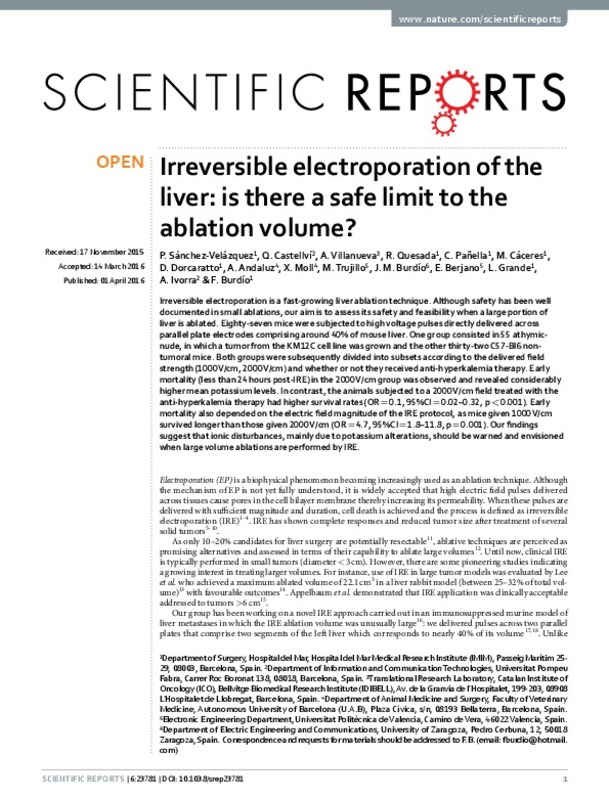Kanthou, C. et al. The endothelial cytoskeleton as a target of electroporation-based therapies. Mol Cancer Ther 5, 3145–52 (2006).
Jarm, T., Cemazar, M., Miklavcic, D. & Sersa, G. Antivascular effects of electrochemotherapy: implications in treatment of bleeding metastases. Expert Rev Anticancer Ther 10, 729–46 (2010).
Davalos, R. V., Mir, I. L. M. & Rubinsky, B. Tissue ablation with irreversible electroporation. Ann Biomed Eng 33, 223–31 (2005).
[+]
Kanthou, C. et al. The endothelial cytoskeleton as a target of electroporation-based therapies. Mol Cancer Ther 5, 3145–52 (2006).
Jarm, T., Cemazar, M., Miklavcic, D. & Sersa, G. Antivascular effects of electrochemotherapy: implications in treatment of bleeding metastases. Expert Rev Anticancer Ther 10, 729–46 (2010).
Davalos, R. V., Mir, I. L. M. & Rubinsky, B. Tissue ablation with irreversible electroporation. Ann Biomed Eng 33, 223–31 (2005).
Chu, K. F. & Dupuy, D. E. Thermal ablation of tumours: biological mechanisms and advances in therapy. Nat Rev Cancer 14, 199–208 (2014).
José, A., Sobrevals, L., Ivorra, A. & Fillat, C. Irreversible electroporation shows efficacy against pancreatic carcinoma without systemic toxicity in mouse models. Cancer Lett 317, 16–23 (2012).
Agerholm-Larsen, B. et al. Preclinical validation of electrochemotherapy as an effective treatment for brain tumors. Cancer Res 71, 3753–62 (2011).
Sersa, G. et al. Vascular disrupting action of electroporation and electrochemotherapy with bleomycin in murine sarcoma. Br J Cancer 98, 388–98 (2008).
Sersa, G. et al. Electrochemotherapy in treatment of tumours. Eur J Surg Oncol 34, 232–40 (2008).
Lee, E. W. et al. Advanced hepatic ablation technique for creating complete cell death: irreversible electroporation. Radiology 255, 426–33 (2010).
Ben-David, E. et al. Irreversible electroporation: treatment effect is susceptible to local environment and tissue properties. Radiology 269, 738–47 (2013).
Charpentier, K. P. Irreversible electroporation for the ablation of liver tumors: are we there yet? Arch Surg 147, 1053–61 (2012).
Niessen, C. et al. Factors associated with short-term local recurrence of liver cancer after percutaneous ablation using irreversible electroporation: a prospective single-center study. J Vasc Interv Radiol 26, 694–702 (2015).
van Lienden, K. P. et al. Short-term effects of combined hepatic vein embolization and portal vein embolization for the induction of liver regeneration in a rabbit model. J Vasc Interv Radiol 23, 962–7 (2012).
Lee, E. W. et al. Irreversible electroporation in eradication of rabbit VX2 liver tumor. J Vasc Interv Radiol 23, 833–40 (2012).
Appelbaum, L. et al. Irreversible electroporation ablation: creation of large-volume ablation zones in in vivo porcine liver with four-electrode arrays. Radiology 270, 416–24 (2014).
Castellví, Q., Sánchez-Velázquez, P., Berjano, E., Burdío, F. & Ivorra, A. Elective Electroporation of liver tumor nodules by means of hypersaline Infusion: a feasibility study. Paper presented at 6thEuropean Conference of the International Federation for Medical and Biological Engineering MBEC, Dubrovnik. (2014, September 7–11th).
Greene, A. K. & Puder, M. Partial hepatectomy in the mouse: technique and perioperative management. J Invest Surg 16, 99–102 (2003).
Treuting, Piper M., and Suzanne M. Dintzis, E. in Comparative anatomy and histology: A Mouse and human Atlas 1st ed edn (eds Treuting, P. M. & Dintzis, S. M.) Ch. 13, 193–199 (Academic Press, 2011).
Ball, C., Thomson, K. R. & Kavnoudias, H. Irreversible electroporation: a new challenge in ‘out of operating theater’ anesthesia. Anesth Analg 110, 1305–9 (2010).
Pech, M. et al. Irreversible electroporation of renal cell carcinoma: a first-in-man phase I clinical study. Cardiovasc Intervent Radiol 34, 132–8 (2011).
Thomson, K. R. et al. Investigation of the safety of irreversible electroporation in humans. J Vasc Interv Radiol 22, 611–21 (2011).
Nielsen, K. et al. Anaesthetic management during open and percutaneous irreversible electroporation. Br J Anaesth 113, 985–92 (2014).
Neal, R. E. et al. Improved local and systemic anti-tumor efficacy for irreversible electroporation in immunocompetent versus immunodeficient mice. PLoS One 8, e64559 (2013).
Hori, T. et al. Simple and reproducible hepatectomy in the mouse using the clip technique. World J Gastroenterol 18, 2767–74 (2012).
Ivorra, A., Al-Sakere, B., Rubinsky, B. & Mir, L. M. Use of conductive gels for electric field homogenization increases the antitumor efficacy of electroporation therapies. Phys Med Biol 53, 6605–18 (2008).
Edhemovic, I. et al. Electrochemotherapy: a new technological approach in treatment of metastases in the liver. Technol Cancer Res Treat 10, 475–85 (2011).
Kingham, T. P. et al. Ablation of perivascular hepatic malignant tumors with irreversible electroporation. J Am Coll Surg 215, 379–87 (2012).
Ness, R. D. In Exotical Animal Formulary 3rd ed. edn (ed Marion, C. J. ) Ch. 8, 375–409 (Elsevier Inc, 2005).
Zhang, G.-F., Duan, M.-L., Zhou, Z.-Q., Yang, J.-J. & Peng, Y. G. Intraoperative tumor lysis-induced fatal hyperkalemia. J Anesth 26, 945–6 (2012).
Rampello, E., Fricia, T. & Malaguarnera, M. The management of tumor lysis syndrome. Nat Clin Pract Oncol 3, 438–47 (2006).
Halperin, M. L. & Kamel, K. S. Potassium. Lancet 352, 135–40 (1998).
Nyirenda, M. J., Tang, J. I., Padfield, P. L. & Seckl, J. R. Hyperkalaemia. BMJ 339, b4114 (2009).
Philips, P., Hays, D. & Martin, R. C. G. Irreversible electroporation ablation (IRE) of unresectable soft tissue tumors: learning curve evaluation in the first 150 patients treated. PLoS One 8, e76260 (2013).
Narayanan, G. et al. Pain analysis in patients with hepatocellular carcinoma: irreversible electroporation versus radiofrequency ablation-initial observations. Cardiovasc Intervent Radiol 36, 176–82 (2013).
Scheffer, H. J. et al. Irreversible Electroporation for Nonthermal Tumor Ablation in the Clinical Setting: A Systematic Review of Safety and Efficacy. J Vasc Interv Radiol 25, 997–1011 (2014).
[-]









